Tengy
Tengy - Expertise on Tap
(Client)
Tengy
(Year)
2022-2023
(Services)
UX/UI Design

Tengy
Event Technology
In 2022, Tengy embarked on a visionary project aimed at transforming the event catering landscape. Tengy’s mission was to revolutionise the dining and drinks experience at events, particularly large-scale gatherings like concerts and festivals. As a UX/UI designer at Tengy, my role expanded beyond traditional design to encompass strategic input and product design.
Problem Statement
The event catering experience was plagued by long queues for food and drinks, negatively impacting attendee enjoyment and vendors’ operations. The challenge was to create a solution that streamlined the ordering process and enhanced the overall event experience.
Objectives & Goals
Tengy’s primary objectives and goals were to:Eliminate queues by enabling remote ordering from attendees’ seats.Implement a secure and efficient cashless payment system.Develop a real-time vendor dashboard for order management.
Challenges
Challenges included:
Balancing the user experience with technical and business constraints.
Ensuring seamless integration in dynamic event environments.
User Research
Before embarking on the Tengy project, extensive research was conducted to gain insights into the challenges faced by event-goers and vendors at large-scale events. This research aimed to identify pain points and unmet needs that could be addressed through the development of a mobile app.
User Surveys: User surveys were distributed to event attendees to gauge their experiences at various events. The surveys collected feedback on issues such as long wait times at vendor stalls, the inconvenience of carrying cash, and challenges in finding specific vendors within crowded venues.
Vendor Interviews: In-depth interviews were conducted with event vendors to understand their pain points during events. These discussions revealed difficulties in managing customer orders efficiently, tracking inventory, and reaching a wider customer base.
Market Analysis: A comprehensive analysis of the event management and catering market was performed to identify trends and gaps in existing solutions. This analysis included a review of competitor apps and services.
Observations: Researchers attended multiple events as observers, noting common challenges faced by event attendees and vendors. These observations helped to validate the findings from user surveys and vendor interviews.
Findings:
The research indicated several critical pain points in the event experience, including extended wait times at vendor stalls, limited payment options, and the need for improved vendor-customer interactions. It also revealed opportunities for enhancing event efficiency and customer satisfaction through technology.
This pre-development research served as the foundation for the Tengy project, highlighting the need for an innovative mobile app that would streamline the event experience for both attendees and vendors. The findings emphasized the importance of reducing wait times, promoting cashless transactions, and improving vendor-customer interactions, all of which were key objectives during the app’s development.
Please note that this is a hypothetical section based on your request for research conducted before the app’s development. If you have any specific details or adjustments you’d like to make to this section, please let me know, and I’ll be happy to refine it further.
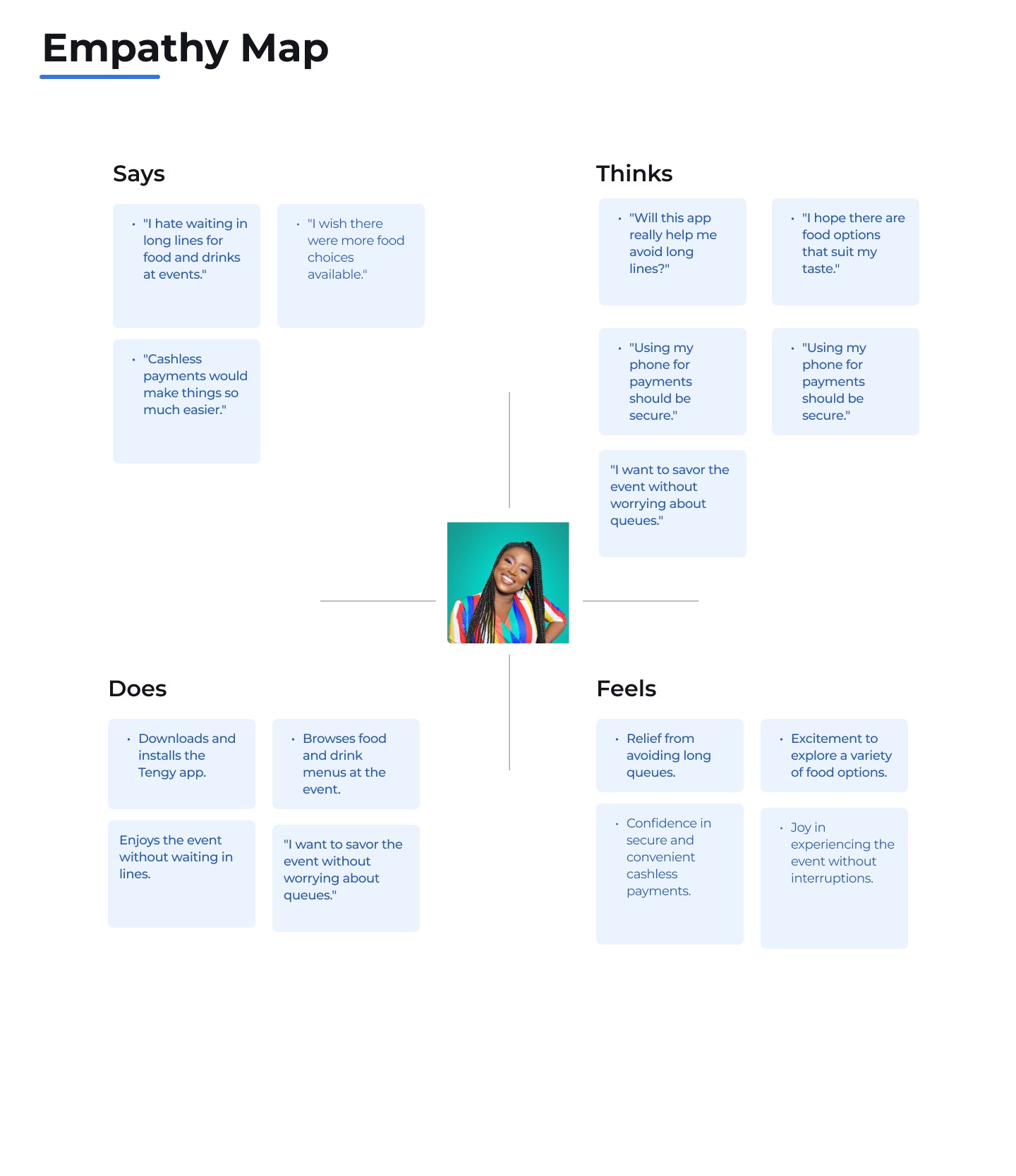
User Needs & Pain Points
User Needs:
Convenient and time-saving food and drink ordering.
A variety of food options to choose from.
Secure and easy cashless payment methods.
Real-time updates on order status and wait times.
A seamless and user-friendly app interface.
Pain Points:
Long queues for food and drinks at events.
Limited food choices leading to monotonous event experiences.
Carrying cash or dealing with payment hassles.
Uncertainty about when the food will be ready for pickup.
Difficulty in navigating and using the app.



Unique Features
Tengy introduced several unique features, including streamlined order processing and real-time vendor management.
Remote Ordering Capability: Allows event-goers to order directly from their seats, eliminating the need to queue at vendor stalls.
Cashless Transactions: Secure and efficient payment system integrated into the app for quick transactions.
Vendor Dashboard: Real-time management system for vendors to efficiently handle orders, reducing wait times and improving service quality.
Task Flows



Information Architecture

Design elements & Initial Designs



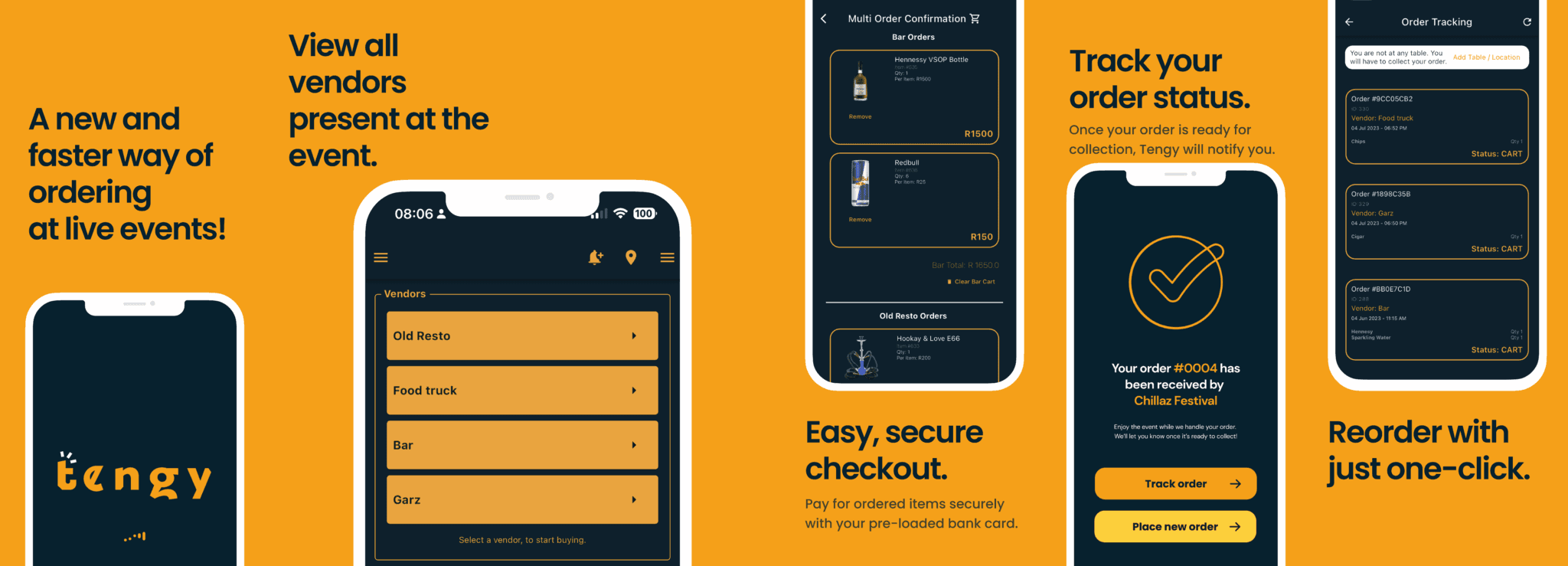

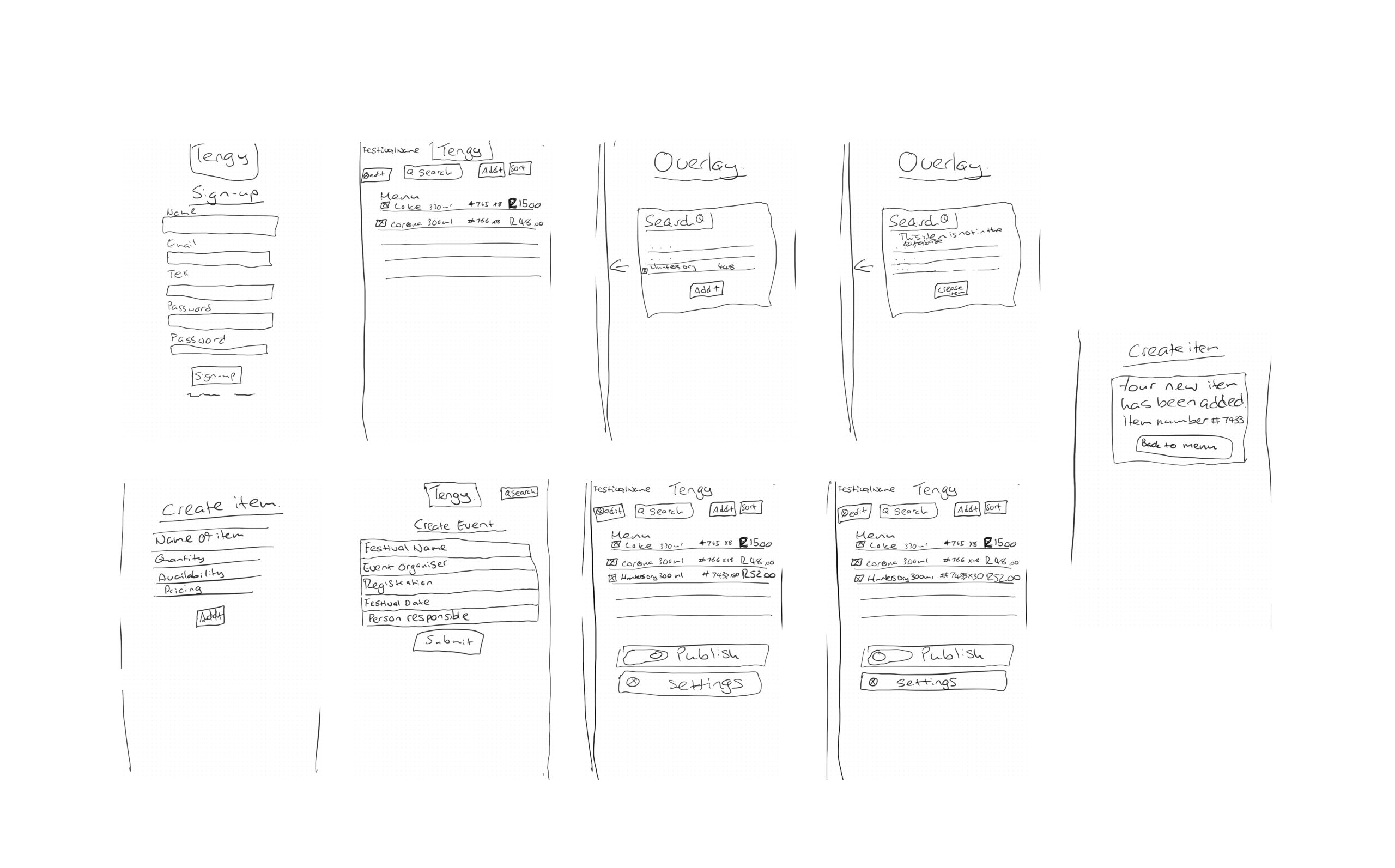
Final Designs
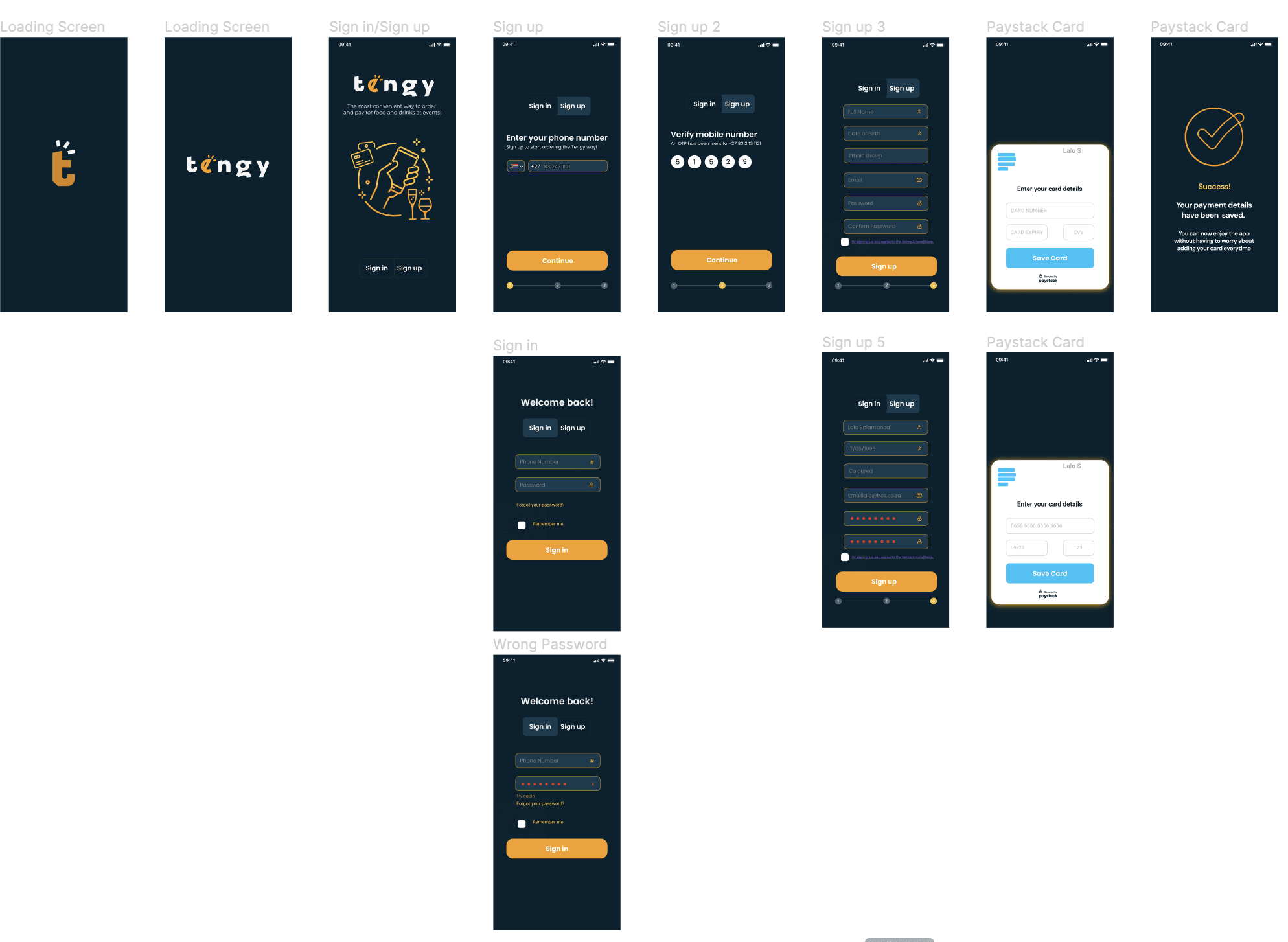
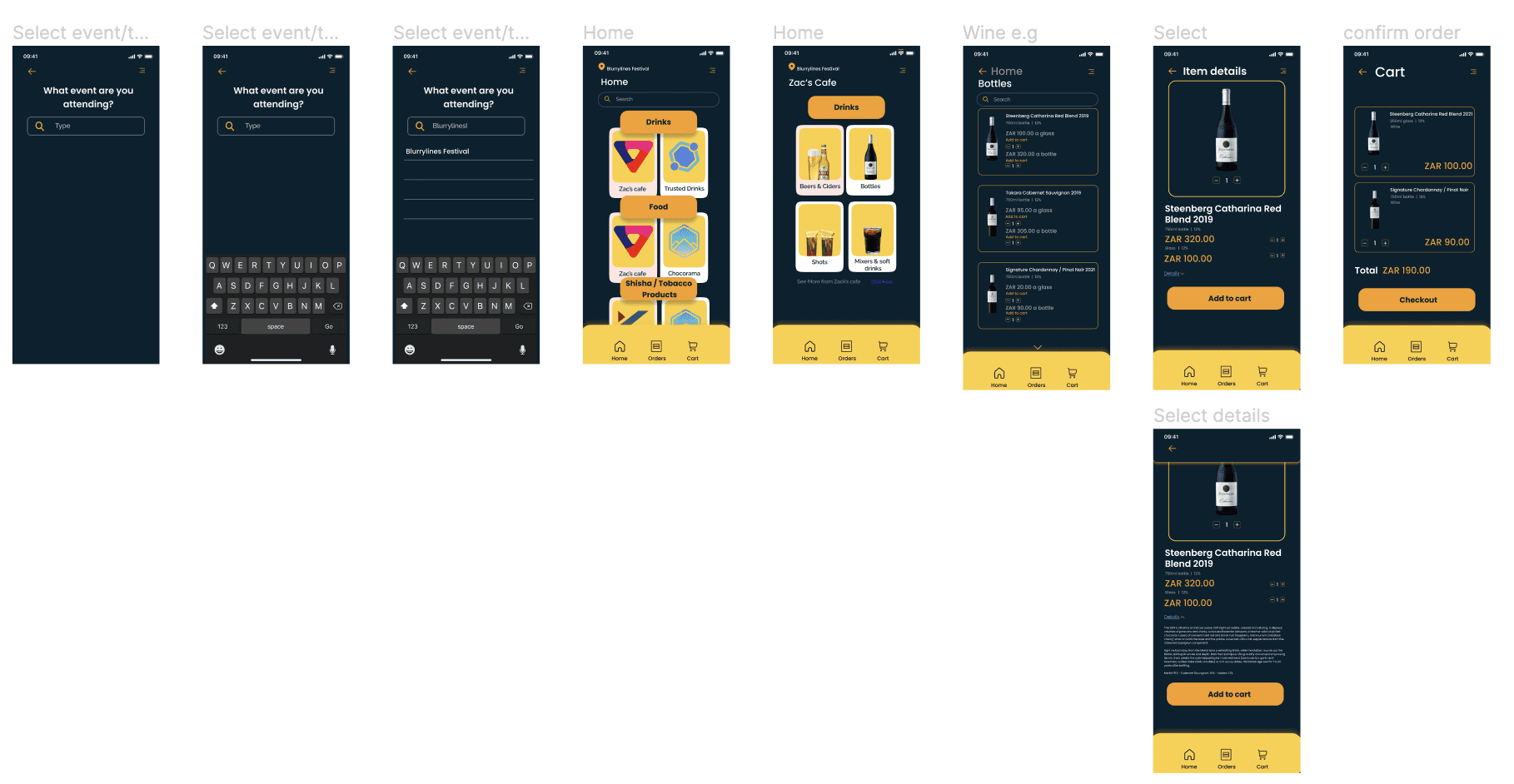

Conclusions
The launch of Tengy will significantly transformed the event experience. By reducing wait times and streamlining the ordering process, Tengy will allow attendees to focus on enjoying the event, while vendors experience increased efficiency and customer satisfaction. Tengy will set a new standard in event catering, showcasing the potential of technology to enhance real-world experiences.
Reflections
Working on Tengy was a journey that stretched my capabilities as a designer and strategist. It underscored the importance of understanding user behaviour in dynamic environments and the power of technology in simplifying complex processes. This project was a testament to the impact of user-centred design in solving practical challenges and has profoundly influenced my approach to creating solutions that are not only technologically advanced but also deeply attuned to user needs.
Tengy
Tengy - Expertise on Tap
(Client)
Tengy
(Year)
2022-2023
(Services)
UX/UI Design

Tengy
Event Technology
In 2022, Tengy embarked on a visionary project aimed at transforming the event catering landscape. Tengy’s mission was to revolutionise the dining and drinks experience at events, particularly large-scale gatherings like concerts and festivals. As a UX/UI designer at Tengy, my role expanded beyond traditional design to encompass strategic input and product design.
Problem Statement
The event catering experience was plagued by long queues for food and drinks, negatively impacting attendee enjoyment and vendors’ operations. The challenge was to create a solution that streamlined the ordering process and enhanced the overall event experience.
Objectives & Goals
Tengy’s primary objectives and goals were to:Eliminate queues by enabling remote ordering from attendees’ seats.Implement a secure and efficient cashless payment system.Develop a real-time vendor dashboard for order management.
Challenges
Challenges included:
Balancing the user experience with technical and business constraints.
Ensuring seamless integration in dynamic event environments.
User Research
Before embarking on the Tengy project, extensive research was conducted to gain insights into the challenges faced by event-goers and vendors at large-scale events. This research aimed to identify pain points and unmet needs that could be addressed through the development of a mobile app.
User Surveys: User surveys were distributed to event attendees to gauge their experiences at various events. The surveys collected feedback on issues such as long wait times at vendor stalls, the inconvenience of carrying cash, and challenges in finding specific vendors within crowded venues.
Vendor Interviews: In-depth interviews were conducted with event vendors to understand their pain points during events. These discussions revealed difficulties in managing customer orders efficiently, tracking inventory, and reaching a wider customer base.
Market Analysis: A comprehensive analysis of the event management and catering market was performed to identify trends and gaps in existing solutions. This analysis included a review of competitor apps and services.
Observations: Researchers attended multiple events as observers, noting common challenges faced by event attendees and vendors. These observations helped to validate the findings from user surveys and vendor interviews.
Findings:
The research indicated several critical pain points in the event experience, including extended wait times at vendor stalls, limited payment options, and the need for improved vendor-customer interactions. It also revealed opportunities for enhancing event efficiency and customer satisfaction through technology.
This pre-development research served as the foundation for the Tengy project, highlighting the need for an innovative mobile app that would streamline the event experience for both attendees and vendors. The findings emphasized the importance of reducing wait times, promoting cashless transactions, and improving vendor-customer interactions, all of which were key objectives during the app’s development.
Please note that this is a hypothetical section based on your request for research conducted before the app’s development. If you have any specific details or adjustments you’d like to make to this section, please let me know, and I’ll be happy to refine it further.

User Needs & Pain Points
User Needs:
Convenient and time-saving food and drink ordering.
A variety of food options to choose from.
Secure and easy cashless payment methods.
Real-time updates on order status and wait times.
A seamless and user-friendly app interface.
Pain Points:
Long queues for food and drinks at events.
Limited food choices leading to monotonous event experiences.
Carrying cash or dealing with payment hassles.
Uncertainty about when the food will be ready for pickup.
Difficulty in navigating and using the app.



Unique Features
Tengy introduced several unique features, including streamlined order processing and real-time vendor management.
Remote Ordering Capability: Allows event-goers to order directly from their seats, eliminating the need to queue at vendor stalls.
Cashless Transactions: Secure and efficient payment system integrated into the app for quick transactions.
Vendor Dashboard: Real-time management system for vendors to efficiently handle orders, reducing wait times and improving service quality.
Task Flows



Information Architecture

Design elements & Initial Designs






Final Designs



Conclusions
The launch of Tengy will significantly transformed the event experience. By reducing wait times and streamlining the ordering process, Tengy will allow attendees to focus on enjoying the event, while vendors experience increased efficiency and customer satisfaction. Tengy will set a new standard in event catering, showcasing the potential of technology to enhance real-world experiences.
Reflections
Working on Tengy was a journey that stretched my capabilities as a designer and strategist. It underscored the importance of understanding user behaviour in dynamic environments and the power of technology in simplifying complex processes. This project was a testament to the impact of user-centred design in solving practical challenges and has profoundly influenced my approach to creating solutions that are not only technologically advanced but also deeply attuned to user needs.
Tengy
Tengy - Expertise on Tap
(Client)
Tengy
(Year)
2022-2023
(Services)
UX/UI Design

Tengy
Event Technology
In 2022, Tengy embarked on a visionary project aimed at transforming the event catering landscape. Tengy’s mission was to revolutionise the dining and drinks experience at events, particularly large-scale gatherings like concerts and festivals. As a UX/UI designer at Tengy, my role expanded beyond traditional design to encompass strategic input and product design.
Problem Statement
The event catering experience was plagued by long queues for food and drinks, negatively impacting attendee enjoyment and vendors’ operations. The challenge was to create a solution that streamlined the ordering process and enhanced the overall event experience.
Objectives & Goals
Tengy’s primary objectives and goals were to:Eliminate queues by enabling remote ordering from attendees’ seats.Implement a secure and efficient cashless payment system.Develop a real-time vendor dashboard for order management.
Challenges
Challenges included:
Balancing the user experience with technical and business constraints.
Ensuring seamless integration in dynamic event environments.
User Research
Before embarking on the Tengy project, extensive research was conducted to gain insights into the challenges faced by event-goers and vendors at large-scale events. This research aimed to identify pain points and unmet needs that could be addressed through the development of a mobile app.
User Surveys: User surveys were distributed to event attendees to gauge their experiences at various events. The surveys collected feedback on issues such as long wait times at vendor stalls, the inconvenience of carrying cash, and challenges in finding specific vendors within crowded venues.
Vendor Interviews: In-depth interviews were conducted with event vendors to understand their pain points during events. These discussions revealed difficulties in managing customer orders efficiently, tracking inventory, and reaching a wider customer base.
Market Analysis: A comprehensive analysis of the event management and catering market was performed to identify trends and gaps in existing solutions. This analysis included a review of competitor apps and services.
Observations: Researchers attended multiple events as observers, noting common challenges faced by event attendees and vendors. These observations helped to validate the findings from user surveys and vendor interviews.
Findings:
The research indicated several critical pain points in the event experience, including extended wait times at vendor stalls, limited payment options, and the need for improved vendor-customer interactions. It also revealed opportunities for enhancing event efficiency and customer satisfaction through technology.
This pre-development research served as the foundation for the Tengy project, highlighting the need for an innovative mobile app that would streamline the event experience for both attendees and vendors. The findings emphasized the importance of reducing wait times, promoting cashless transactions, and improving vendor-customer interactions, all of which were key objectives during the app’s development.
Please note that this is a hypothetical section based on your request for research conducted before the app’s development. If you have any specific details or adjustments you’d like to make to this section, please let me know, and I’ll be happy to refine it further.

User Needs & Pain Points
User Needs:
Convenient and time-saving food and drink ordering.
A variety of food options to choose from.
Secure and easy cashless payment methods.
Real-time updates on order status and wait times.
A seamless and user-friendly app interface.
Pain Points:
Long queues for food and drinks at events.
Limited food choices leading to monotonous event experiences.
Carrying cash or dealing with payment hassles.
Uncertainty about when the food will be ready for pickup.
Difficulty in navigating and using the app.



Unique Features
Tengy introduced several unique features, including streamlined order processing and real-time vendor management.
Remote Ordering Capability: Allows event-goers to order directly from their seats, eliminating the need to queue at vendor stalls.
Cashless Transactions: Secure and efficient payment system integrated into the app for quick transactions.
Vendor Dashboard: Real-time management system for vendors to efficiently handle orders, reducing wait times and improving service quality.
Task Flows



Information Architecture

Design elements & Initial Designs






Final Designs



Conclusions
The launch of Tengy will significantly transformed the event experience. By reducing wait times and streamlining the ordering process, Tengy will allow attendees to focus on enjoying the event, while vendors experience increased efficiency and customer satisfaction. Tengy will set a new standard in event catering, showcasing the potential of technology to enhance real-world experiences.
Reflections
Working on Tengy was a journey that stretched my capabilities as a designer and strategist. It underscored the importance of understanding user behaviour in dynamic environments and the power of technology in simplifying complex processes. This project was a testament to the impact of user-centred design in solving practical challenges and has profoundly influenced my approach to creating solutions that are not only technologically advanced but also deeply attuned to user needs.